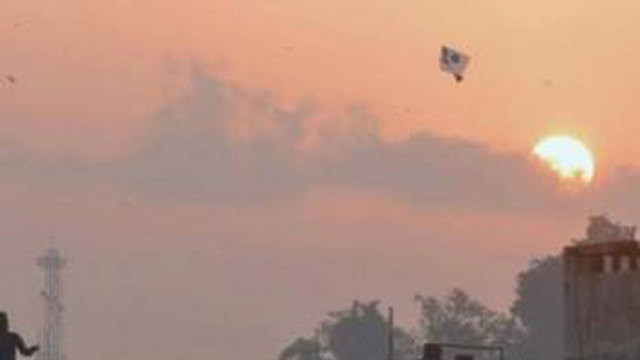

Kites and GoPros: Hamas prepares for war with Israel
As Hamas prepares for the next round of fighting in Israel, the IDF anticipates the terrorist organization's utilizing its tunnels to infiltrate border communities to carry out mass casualty attacks; there has been an uptick in activity at Hamas training camps.
The terrorist organization that rules the Gaza Strip is using kites with GoPros attached to them to surveil Israeli border communities and track IDF movements. The Israeli military has noticed that this trend is increasing.
Army forces are deployed every time one of these surveillance kites is spotted. The Hamas surveillance missions are typically carried out during the day, with the terrorists arriving to the border with their kites in pickup trucks.
The surveillance kites are usually brought down quickly when the IDF arrives, as Israel either shoots them down or fires warning shots at the trucks holding Hamas militants. The IDF sees these kites as yet another way that Hamas is preparing for the next round of fighting against Israel.
During the next round of fighting, the IDF estimates that Hamas will try to damage Israeli morale by rapidly striking civilians in the Gaza border area before Israel has a chance to mobilize its forces to stem the Hamas attacks.
This "opening shot" is expected to be carried out in a multi-pronged Hamas attack that will see dozens of Hamas Special Forces operatives from the Nukaba force enter and attack the border communities. They are expecting Hamas operatives to emerge from tunnels in Israel with motorcycles and believe that the terrorists will then drive to a nearby Israeli town to kill and capture civilians.
Hamas will also most likely infiltrate Israel from the sea, the IDF has decided with a combined force of frogmen and swift boats at the same time.
The IDF Gaza Division practiced defending against these threats last week.
Drones and Special Forces training
Hamas is also using low-cost drones to surveil IDF forces and Israeli towns on the border with Gaza. They are doing this In conjunction with intensely training their marine Special Forces units, digging tunnels with greater frequency, and improving their rocket arsenal. They are also carrying out more long-range rocket tests into the sea.
Hamas has been surveiling Israeli movements from the ground as well, and has continued to build lookout points all along the Gaza border with Israel. They are sometimes building their outposts just a few hundred feet from IDF outposts.
Hamas has equipped these outposts with advanced optics. They are able to be easily moved as Hamas fears that these expensive, hi-tech optical systems will be attacked and destroyed by the IDF should a rocket or mortar round from Gaza hit Israel.
However, the IDF sees two positives regarding these Hamas drills and surveillance methods; the first is that it shows that the Hamas military wing is becoming institutionalized, and helps the IDF understand how the military wing operates – all of which can be used to the IDF's advantage during wartime.
The second positive is that with so many Hamas military wing members in the area, it is becoming harder for Palestinians to illegally cross the fence into Israel.
A recent tour of the Gaza border area also revealed several positive signs – the IDF Combat Engineering Corps is working around the clock to strengthen the underground barrier between Gaza and Israel, a barrier which is designed to detect and deter tunnel digging.
The IDF has also noted an uptick in military drills at Hamas training camps along the border with Israel. These drills include basic exercises, shooting drills, and practicing urban warfare both during the day and at night.
The IDF has also noticed that the buildings damaged in the Shujaiyeh neighborhood are being demolished by Hamas. The IDF has evidence to suggest that the cement from these destroyed buildings is being recycled by the terrorist group for the purpose of building tunnels. They believe this is the case as there has been very little rebuilding or refurbishment of structures destroyed in the neighborhood during Operation Protective Edge.


















